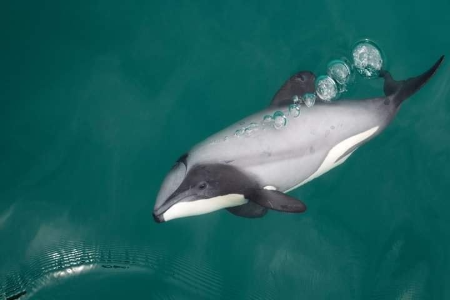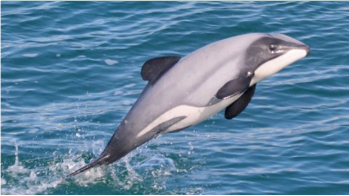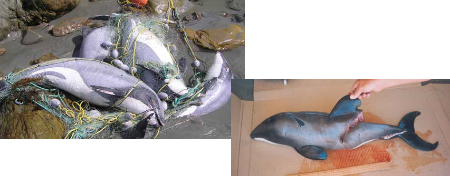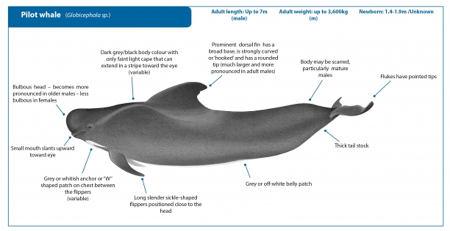Rehabilitated penguins
Dolphins are amazing and we need them?
Dolphins are amazing… and we need them!
Dolphins are seen by most people as charismatic animals. They amaze us with their intelligence, their grace, their acrobatic skills and with their ability to play and interact with human kind sometime. But what we see is just a tiny part of the dolphin’s world. Most of their world is underwater and beyond what we are capable of perceiving. Dolphins play an important role in the whole marine eco-system.
- Dolphins help keep their environment in balance : they are predators - eating mainly fish and squid - but they are also prey to bigger predators such as shark, and killer whales. Without dolphins the natural balance that exists in the food chain would be disrupted and would ultimately affect other wildlife in the ocean.
- Dolphins act as bio-indicator, according to the Institute of Marine Mammals. By monitoring dolphins in their environment, we can find out if something is going wrong ( like water pollution) in the ocean. Therefore, dolphin studies help protect other marine wildlife and humans as well since we eat some of the same food.
- Dolphins often prey on ill or old fish. By doing so, dolphins help stop the spread of infectious diseases among fish populations. This keeps more fish species healthy and alive to reproduce. For example, dolphin may eat fish poisoned by ciguatera (a toxin affecting humans but not dolphins). Since humans can be food-poisoned by ciguatera, dolphins help keep infected fish off the table!
Dolphins are precious allies to other species and us, humans. Without dolphins, there would be more disease and lower fish populations in the ocean. We need to protect them, not just because we love them, but also because we need them 😊
Dolphins in New-Zealand
There are 9 different species of dolphins found around New-Zealand. The smallest and rarest dolphin is the Hector/Maui dolphin. Here is a description of this very precious dolphin, followed by a description of the other species found in NZ waters.
Hector’s dolphin/Tupoupou (Cephalorhynchus hectori hectori)
Conservation status : nationally endangered
Named after James Hector who is believed to be the first person to have thoroughly examined this species.
Grey with black and white markings and a round dorsal fin, the Hector’s dolphin is easily recognised.
Endemic of New-Zealand, Hector’s dolphin is among the smallest marine dolphins in the world, reaching 1.5 meter long at maximum and weighing between 40-60 kg. Male are slightly smaller and lighter than female.
There are 2 sub-species :
- the South Island Hector’s dolphin found around the South Island and
- the Maui dolphin/popoto (Cephalorhynchus hectori maui) found off the West coast of the North Island.
The Maui dolphin is even more endangered (Nationally critical) than the Hector’s dolphin due to its very small population.

Photo by Mark Kitchingman
What do Hector dolphins eat?
Hector dolphins eat fish, squid and crab. Their diet is believed to be more influenced by the size of the prey rather than the type. They hunt in pods of up to 8 dolphins. Like the other species of dolphins, Hector’s dolphin use echolocation to find their prey : they produce high frequency “clicks” that bounce off objects and animals and give them a picture of what surround them.
Social behaviour
Hector’s dolphins usually travel in small pods of up to 5, although can be seen in larger pods (20 or more) especially during mating period.
They communicate using clicks and whistles and interact in different ways such as chasing each other, leaping out of the water, blowing bubbles and playing with seaweed.
Hector’s dolphins are known to be very curious species approaching and swimming near boats.

Dolphin leaping out of the water
Breeding
Hector’s dolphin mate around the summer months, the gestation period is 10-11 months. They reach sexual maturity between 5-9 years, females being mature later than the males.
Each female gives birth to a calf only every 2 to 3 years - which makes their population increase at very slow rate - and produce only 4 or 5 calves in a lifetime. Calves stay with their mother for up to 2 years.
Hector’s dolphins live to around 20 years of age.
Threats
Their conservation status is nationally vulnerable (critical for the Maui dolphin), with a decreasing population.
Natural predation of Hector’s dolphins includes sharks and killer whales (orcas).
Human threats to the Hector dolphin include fishing methods, oil and gas exploration, boat strike, mining, tourism, noise…
A major threat for Hector’s dolphins (and other dolphins) is set net fishing. Dolphins can get caught in the net, then not able to come back to the surface to breathe air (remember, dolphins are mammals therefore have lungs and need air to survive) they sadly die drowning or suffocating. Dolphins can also be killed or harmed by boats.
Due to pollution, boating, fishing and recreational activities over the past 30-40 years, the population of dolphins has significantly reduced from 26,000 to less than 14,000.
Despite actions made toward the protection of Hector’s and Maui dolphins, dolphins are still found caught in nets and accidentally killed by boat and might face extinction is no further/better protection is made to support their survival.

| A Hector dolphin's calf killed by a propeller. Photo Al Hutt | Hector dolphin tangled in net. Photos by Department of Conservation |
Some very sad discoveries that could be avoided with a better Threat Management Plan?
Other species of dolphins in NZ include :
Dusky dolphin (Lagenorhynchus obscurus) :
Conservation status : Not theatened
Found around NZ mainly South of East Cape but also around South America, off south eastern Africa. In New-Zealand the main population are found in Kaikoura and Admiralty Bay. There are thought to be between 12,000 and 20,000 Dusky dolphins in New-Zealand.

Picture by International Whaling commission
Bottlenose dolphin/Terehu (Tursiops truncatus)
Conservation status: Nationally endangered
Bottlenose dolphins are widely distributed throughout the world in cold temperate and tropical seas. New Zealand is at the Southern most point of their range. Limits to the range of this species appear to be temperature related.
Bottlenose dolphins are found both offshore ad in many enclosed areas such as the Mediterranean, Black ad Red Seas.
In New Zealand 3 main coastal populations exist:
- Around 450 individuals live in the North Island area. There are currently 96 individual dolphins visiting the Bay of Islands area
- Around 63 live in Doubtful Sound, Fiordland (as at 1998)
- Another group range from the Marlborough Sounds to Westport.

Picture by International Whaling commission
Common dolphin/aihe (Delphinus delphis):
Conservation status : Not threatened
Found in offshore warm-temperate waters in the Atlantic and Pacific, common dolphin is the most numerous dolphin within this range. It is closely related to the long-beaked common dolphin (Delphinus capensis) which prefers shallower and warmer water.
Short-beaked common dolphins are found in waters throughout New Zealand and Australia. In New Zealand, this species tends to remain a few kilometres from the coast and is particularly common in the Hauraki Gulf and off Northland.
Common dolphins may form enormous schools of several thousand individuals. They are also known to associate with schools of pilot whales and other dolphin species such as dusky dolphins. This species is abundant but precise population estimates are largely unknown.

Picture by International Whaling commission
Orca (killer whale)/maki (Orcinus orca)
Conservation status : Nationally critical
Despite its name Orca is the largest member of the dolphin family. There are an estimated 150–200 individuals in New-Zealand, which travel long distances throughout the country’s coastal waters.
Orca are typically encountered in family groups or pods. Pods are usually formed for life and can result in the development of unique dialects.

Picture by International Whaling commission
Pilot whale (Long-finned)/upokohue (Globicephala melas edwardii)
Conservation status : Not threatened
Pilot whales, despite their name, belong to the dolphin family. Male can grow over 6 meters in length, the female can reach 5 meters.
Long-finned pilot whales are found throughout the Southern Ocean. A sub-specie lives in the North Atlantic. They usually are occuring in groups of 20-50 individuals but larger herds of several hundreds have been seen.
Pilot whales like swimming in areas that are topographically "steep" (high relief, such as submerged banks and the edge of the continental shelf. Their preference for steep landforms may partially explain their tendency to strand – their sonar may not function so well in the shallow, gently sloping underwater environments that are typical of high-stranding areas such as Golden Bay.

Picture by International Whaling commission
What can you do to help dolphins?
(ref. Department of conservation)
Report your sighting : If you are in the North Island and think you’ve seen a Māui or Hector’s dolphin, report it straight away to our emergency hotline 0800 DOC HOT (0800 362 468). Include as much information as possible with your sighting:
- the date, time and location (GPS coordinates if possible)
- the number of dolphins and estimated sizes
- the direction they were travelling
- take photographs or video if possible.
You can also choose to join some of the many operators like ourselves that have voluntarily signed up for the DOC SMART accreditation which encourage education by exemplary good behavior around marine mammals. So if you consider joining a harbour cruise or a sea-kayaking tour look for this extra logo and support those who wants to make a difference.
![]()
How to approach dolphins
From a boat:
- carefully approach dolphins from their side and slightly to the rear.
- operate your boat slowly and quietly at ‘no wake’ speed within 300 m.
- don't approach a group of dolphins if three or more boats are already within 300 m of the group.
- manoeuvre your boat carefully. Do not obstruct their path, cut through a group, or separate mothers from calves.
From a boat or swimming:
- avoid loud or sudden noises that could startle dolphins.
- don't swim with dolphins when calves are present.
- don't try to touch the dolphins or feed them.
- co-operate with others so all may see the dolphins without putting them at risk.
Stranded, injured, entangled, or deceased dolphins
Call DOC's emergency hotline immediately 0800 DOC HOT (0800 362 468) and follow any instructions from DOC staff.
Prompt reporting increases the likelihood that we can save dolphins in distress and learn more about deceased dolphins, including conducting necropsies in some situations to identify the cause of death and to collect important scientific data that may help us manage threats to dolphins.
|
Ideally, we don’t want to handle our penguins at all. However, some of them need our help whether it be from an injury, illness or malnourishment. Pohatu Penguins steps in and gives these little birds a second chance at life! Most of our rehabilitated penguins are underweight or malnourished chicks. Typically, we find these chicks during our tours as we monitor the nesting sites. Why are the chicks malnourished/underweight?
What do you do in rehabilitation? This depends on the penguins needs and condition. Typically we will feed them 2-3 times a day depending on their weight and age. If they are old enough we will bring them for a swim in our “swim therapy pool”. Here, we introduce them to the water and determine if they are ready to be released. Injured or sick penguins will be sent to either a specialized penguin vet or dedicated specialists, Kristina and Thomas*, in Christchurch where they are assessed for future placement. Permanently injured penguins have the chance to live out their lives at the Antarctic Centre. *K&T Link: https://www.stuff.co.nz/environment/88518082/christchurch-couple-give-injured-rescue-penguins-the-full-pamper-treatment ParniaI spotted Parnia while kayaking; she was standing on the rocks looking extremely thin and weak. After getting back onto shore I quickly grabbed a bucket and went on to retrieve her – she gave little resistance to capture. Once I saw her up-close I realized that she had a deformed beak, probably why she had been so thin. (It’s very difficult for penguins to hunt efficiently with a crooked beak, most die.) I had never seen such a thin penguin and I expected her to die within the day, but still it was worth a shot to try and save her. Penguin band: P 41 087One year a starvation event happened right in the middle of the breeding season. When starvation occurs parents stop feeding their chicks to save themselves or only do so periodically. Chicks are then forced to leave (or fledge) the nest early in search of food. Unfortunately, chicks under 8 weeks old are not properly equipped to survive at sea and either starve or drown. In order to prevent early fledgings I fed the chicks while they remained in their burrows, hoping that the starvation event would end soon. Slowly but surely the parents started to return consistently feeding their youngsters and relieving me of my duties! Two years later P41 087 (we used to band our penguins) turned up in one of my breeding boxes. He was one of the largest, most beautiful penguins I had ever seen. P41 087 was evidence that my feedings, two years ago, had been a success. It warmed my heart to know that I helped save this little penguin and build him up for a healthy, successful life in the wild. He was my pride and joy. RoxyRoxy was handed in by the Fox II, a tourist sailing boat in Akaroa. She was extremely thin with a severe injury to her eye. Roxy looked like a recently fledged chick that seemed to have been hit by a boat. Her condition was very grim and I had my doubts about her survival.
However, to my delighted surprise she survived the first 24-hours, then the next and the next, and by day 3 she was on the road to recovery! Her eye injury, however, would be permanent and she would never be able to see from it again. Although, she was doing well in rehabilitation we knew that she wouldn’t stand a chance in the wild, thankfully, Roxy was also sent to the Antarctic Centre where she’ll live out a long and luxurious life! Shark baitThis is an all time favorite story that demonstrates incredible intelligence – intelligence you would never expect from a penguin. One night, while running an Evening Penguin Tour, we found a horribly injured penguin beside the track. I immediately took him into care and the next morning rushed him to Christchurch for an emergency veterinary assessment.. He had several shallow, flesh wounds and a lacerated leg. We suspected the culprit had been a shark. The vet stitched him up and I took him home to recover.. He spent a few weeks with us recovering and eating lots of fish – something he was quite happy to do through his moult*! Once his moult was complete we returned him to the sea and he happily shot off like a rocket! One year later, while running a tour, in the same spot on the tarck out in the open, we found a penguin near the track and out in the open we found a penguin that did move away from us as he should. He also did not attempt to bit and was very relaxed when I picked him up to examine him to find an explanation for this strange behaviour. He was in very good condition, but lame in one leg as Shark bait was when we released him. He proved beyond doubt who we was when I tried to feed him. He snapped and gulp the fish down gleefully and then looked for more, greedy as ever. As he was looking forward to another free easy loading molt we decided to indulged him and sent him on his way, fat and sleek once his feathers were grown in. Once again he shot off, instantly a wild penguin, but we did wonder, would he be back next year for another easy moult*? *Little Penguins moult – loose their old feathers and grow new ones – for two weeks every year. During the moult they cannot hunt and thus starve until it is complete. Yappy WiggleThis was the funniest penguin I’ve ever cared for! One day, while monitoring nesting sites I came across a burrow with one healthy chick and one very small runt. If one chick gets too far behind they simply die and the fouled nest can cause the healthy chick to become sick and die. The best option was to take the runty chick out, but then what to do with it? I decided I would simply throw it in the bushes. It’s very difficult to raise chicks that are less than 2 weeks old, especially if they are runts, but I thought I’d give it a go. Trying to feed such a young chick was not easy, but the little guy responded well and started to put on weight. Soon enough he turned into a healthy, respectable penguin. He became far too tame, however, and ran around like a puppy dog, wiggling his tail and begging for food with sharp, yapping noises. When it came time for him to leave he wasn’t exactly keen. On the first release he returned the next day yapping his way up the drive, begging for more fish. He had obviously not found any for himself. I allowed him to stay for a few days until I figured that we better try again; so, for a second time we released him back into the wild. He returned the very next day for more fish. I fed him once more and came up with a new idea, we’ll release him by kayak! So, in our third release, we took him by kayak to the entrance of Flea Bay and let him go. This seemed to be successful until the fifth day when we saw him hobbling towards the house. This time he was much weaker, thinner and a bit injured. I assumed he had hurt himself along the rocks and barnacles while exiting the sea. After our third try, we realized that Mr. Yappy Wiggle had imprinted on us and would not succeed in the wild. He now happily resides in the Antarctic Centre yapping and wiggling all over the place! Our Christmas Eve SagaBefore you read this you must understand: Yellow Eyed Penguins are the rarest penguin in the world and are extremely endangered. Every single one is precious. One Christmas Eve during a penguin tour we saw one of our Yellow Eyed Penguins drag itself ashore, obviously injured and bleeding. We caught the Yellow Eyed to gauge its injuries in which its feet were badly cut. It looked as though it kicked itself free from the jaws of life and escaped a near death shark attack. It needed stitching as soon as possible if it was to survive, but what vet would be open on Christmas Eve or Christmas Day? Talk about bad timing. I rang our closest vet in Little River and to my surprise he said to bring it straight over. This was 10.00pm on Christmas Eve. We arrived in Little River at 11.30pm, but the vet was nowhere to be seen. We sat there waiting and silently panicking over this precious penguin’s life. Until suddenly a vehicle pulls up with the vet and vet’s family! In order to successfully and painlessly stitch the penguin he needed to be put under. However, this can be dangerous if the penguin has a full stomach – something we weren’t sure about. We simply had to hope for the best and move forward with the procedure. The penguin did not fair well with the gas, he kept drifting in and out of conscious. Then, suddenly he started to heave and projectile vomit fish across the table, the floor and even the walls! Now, you can imagine our surprise, you can also imagine that it was quite unexpected and unfortunately we did not have time to react. So, like the table, the floor and the walls, we too were covered in fish vomit. Merry Christmas indeed! Thankfully after loosing its stomach contents our Yellow Eyed Penguin drifted into sleep and the vet was able to finish the job. With stitched and bandaged feet we placed our groggy penguin back into our vehicle. As we had to get the penguin home our vet and his family had to clean up the fish vomit – lucky them! We bid farewell and wished our Christmas heros a very Merry Christmas. After Christmas I sent the penguin to Christchurch to my wonderful friends and penguin rehab specialists, Christina and Thomas. Once it healed properly we released our Christmas penguin back into the wild. |
 Feeding chicks Feeding chicks Rehabilitated penguins in our garden going for a walk  Swim! (allow the penguins to oil up their feathers)  Releasing an adult.  Two chicks ready to go! (White flippered and Little Blue)  Trying to release Yappy Wiggle.  Still trying to release Yappy Wiggle...  Yellow Eyed Penguin with stitched foot.    |
|
These are just a few of the more memorable birds we have had in care. We rehabilitate many penguins, mostly Little Penguins, sometimes Yellow Eyed and occasionally a Crested Penguin. Most are sent off to sea successfully! If you too wish to help visit our Adopt a penguin page. |


Comments